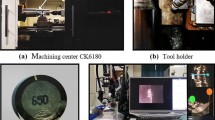Abstract
This paper presents an online prediction of tool wear using acoustic emission (AE) in turning titanium (grade 5) with PVD-coated carbide tools. In the present work, the root mean square value of AE at the chip–tool contact was used to detect the progression of flank wear in carbide tools. In particular, the effect of cutting speed, feed, and depth of cut on tool wear has been investigated. The flank surface of the cutting tools used for machining tests was analyzed using energy-dispersive X-ray spectroscopy technique to determine the nature of wear. A mathematical model for the prediction of AE signal was developed using process parameters such as speed, feed, and depth of cut along with the progressive flank wear. A confirmation test was also conducted in order to verify the correctness of the model. Experimental results have shown that the AE signal in turning titanium alloy can be predicted with a reasonable accuracy within the range of process parameters considered in this study.
Similar content being viewed by others
References
Levi R, Villa A, Quaglia G, Ghiara R, Rutelli G (1985) An expert control system for tool life management in flexible manufacturing cells. Ann CIRP 34:87–90
Sadat B, Raman S (1987) Detection of tool flank wear using acoustic signature analysis. Wear 115:265–272
Uehara K (1972) On the mechanism of crater wear of carbide cutting tool. Ann CIRP 21:31–32
Cook NH (1980) Tool wear sensors. Wear 62:49–57
Gomayel JLE, Bregger KD (1986) On-line tool wear sensing for turning operations. J Engg Ind 108:44–47
Tlusty J, Andrews GC (1983) A critical review of sensors for unmanned machining. Ann CIRP 32:536–572
Lan MS, Dornfeld DA (1984) In-process tool fracture detection. J Engg Mater Tech 106:111–118
Constantinides N, Bennett S (1987) An investigation of methods for online estimation of tool wear. International Journal of Machine Tools and Manufacture 27(2):225–237
Liao YS (1974) Development of a monitoring technique for tool change purpose in turning operations. Proc. 15th Int. Machine Tool Design and Research Conf., 251–257
Takeyama H, Sekiguchi H, Murata R, Matsuzaki H (1976) In-process detection of surface roughness in machining. Ann CIRP 25:467–471
Dolinsek TA (1992) Friction-induced vibration, chatter, squeal and chaos: part 2—dynamic and modelling. Friction-Induced Vibration, Chatter, Squeal and Chaos, ASME, DE-Vol. 49, 123–138
I I (1998) Applications of acoustic emission sensor for monitoring machining processes. Ulterasonics 36:273–281
Grosse CU, Ohtsu M (2008) Acoustic emission testing. Springer, Berlin
Dolinsek S, Kopac J (1999) Acoustic emission signals for tool wear identification. Wear 225–229:295–303
Sundaram S, Kumar SP, Manoharan N (2007) Study of acoustic emission sensor techniques for monitoring machining process. Journal Eng Applied sci 2(1):1581–1586
Miinshiou H, Liang J, Liaw PK, Brooks CR, Seeley R, Klrarstrom DL (1998) Using acoustic emission in fatigue and fracture materials research. Japan: Asia-Pacific Vibration Conference. 78–85
Xiaoli L (2002) A brief review: acoustic emission method for tool wear monitoring during turning. International Journal of Machine Tools and Manufacture 42:157–165
Datta S, Bandyopadhyay A, Pal PK (2008) Grey-based Taguchi method for optimization of bead geometry in submerged arc bead-on-plate welding. Int Journal Advanced Manufacturing Technology 39(11):1136–1143
Author information
Authors and Affiliations
Corresponding author
Rights and permissions
About this article
Cite this article
Kosaraju, S., Anne, V.G. & Popuri, B.B. Online tool condition monitoring in turning titanium (grade 5) using acoustic emission: modeling. Int J Adv Manuf Technol 67, 1947–1954 (2013). https://doi.org/10.1007/s00170-012-4621-2
Received:
Accepted:
Published:
Issue Date:
DOI: https://doi.org/10.1007/s00170-012-4621-2




